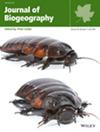Cryptic Diversity in the Living Fossil Barnacle Ibla cumingi (Phosphatothoracica: Iblidae) Across the Indo-Pacific Is Driven by Multiple Vicariant Events From the Late Miocene to the Pleistocene
Abstract
Aim
Ibla cumingi, a rocky intertidal barnacle, belongs to the order Iblomorpha, which is known as a living fossil with plesiomorphic characters and of Palaeozoic origin. This species lives cryptically inside crevices across the Indo-Pacific. We aim to investigate the phylogeography of this ancient barnacle, to test whether it forms a single phylogenetic unit or consists of different clades of long palaeo-historical or recent isolation, representing separate ancient populations.
Location
Indo-Pacific.
Taxon
Ibla cumingi (Cirripedia: Phosphatothoracica: Iblidae).
Methods
The phylogeny was reconstructed using Bayesian analyses in BEAST, based on two nuclear markers (28S and 18S) and four mitochondrial markers (COX1, ND1, 16S and 12S). Phylogeographic and genetic structure analyses, including haplotype network construction and analyses of genetic differentiation among populations, were performed based on COX1 and 16S sequences.
Results
Phylogenetic analyses recovered six geographically isolated clades, one from the Western Indo-Pacific and five distributed in the Central Indo-Pacific (CIP). Three out of five CIP clades were from western, northern and eastern Australia, with the latter holding the basal position. The most widespread clade was the South China Sea clade, distributed from Malaysia to Okinawa, showing shallow divergence between the western localities (Malaysia and Thailand) and the eastern localities (Vietnam to Okinawa).
Main Conclusions
Patterns from phylogenetic analyses revealed Australia is the origin of distribution, at least for the CIP lineage of I. cumingi. Molecular clock and the ranges of genetic distances confirm that the present-day geographic clades of this ancient barnacle are the results of recent (late Miocene to Pleistocene) vicariant events. Allopatric distribution of these six clades confirms that the oceanic barriers like the Indo-Pacific Barrier and Indonesian Throughflow are actively restricting genetic connectivity between clades. The localities in the South China Sea clade are connected by the help of oceanic currents in the South China Sea and northwestern Pacific.

 求助内容:
求助内容: 应助结果提醒方式:
应助结果提醒方式:


